
Editor's note
"A new world is born".
The Mother and Sri Aurobindo have worked ceaselessly to bring a new consciousness on earth, - the Supramental or Truth Consciousness. It is now concretely present.
To collaborate with its action a big change is needed. The Integral Yoga is a help or a path on the way, leading and guiding our consciousness towards the perfection and transformation of our present being and nature.
The messages or spiritual significances of the flowers revealed by the Mother offer us the promise of beauty, the support to our aspiration, as well as the Grace, the blessing they embody, -- working in a subtle way. This leads us to a wider and deeper understanding of ourselves, of life and the world, and helps us to transform ourselves.
The Collaboration of Nature
“Life must blossom like a flower offering itself to the Divine”
“Be like a flower. One must try to become like a flower: open, frank, equal, generous and kind. A flower is open to all that surrounds it: Nature, light, the rays of the sun, the wind, etc. It exerts a spontaneous influence on all that is around it. It radiates a joy and a beauty.
 |
| Avatar-the Supreme Manifested in a Body upon Earth (Nelumbo nucifera) pink lotus |
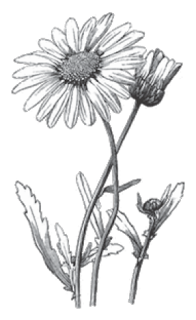 |
| Frankness, (Gerbera jamesonii) |
It is equal: it has no preference. Everyone can enjoy its beauty and its perfume, without rivalry. It is equal and the same for everybody. There is no difference, or anything whatsoever.
Then generous: without reserve or restriction, how it gives the mysterious beauty and the very own perfume of Nature. It sacrifices itself entirely for our pleasure, even its life it sacrifices to express this beauty and the secret of the things gathered within itself.
And then, kind: it has such tenderness; it is so sweet, so close to us, so loving; its presence fills us with joy; it is always cheerful and happy.
Happy is he who can exchange his qualities with the real qualities of the flowers. Try to cultivate in yourself their refined qualities.
I give you flowers so that you may develop the divine qualities they symbolise. They can directly transmit into the psychic all that they contain, pure, unalloyed. They possess a very subtle and very deep power and influence. Do you understand? Now, it seems to me that you wish to become like a flower or cultivate these qualities. And, you know, each flower symbolises an aspect, an emanation, an aspiration and a progress in the evolution of the earth.”
*
 |
| Tenderness for the Divine (Rosa chinensis) |
“The fragrance of flowers is physical Nature’s offering to the Divine, her most subtle offering.”
*
“It’s largely the fragrances that have made me give flowers their significance. I find these studies quite interesting; it corresponds to something really true in Nature.”
*
“The movement of love is not limited to human beings and it is perhaps less distorted in other worlds than in the human. Look at the flowers and trees. When the sun sets and all becomes silent, sit down for a moment and put yourself into communion with Nature: you will feel rising from the earth, from below the roots of the trees and mounting upward and coursing through their fibres up to the highest outstretching branches, the aspiration of an intense love and longing, — a longing for something that brings light and gives happiness, for the light that is gone and they wish to have back again. There is a yearning so pure and intense that if you can feel the movement in the trees, your own being too will go up in an ardent prayer for the peace and light and love that are not manifest here.”
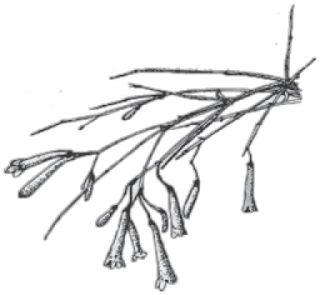 |
| Aspiration in the Physical for the Divine Love, (Russelia equisetiformis) |
*
“The unselfish movement, uncalculating, is one of the most beautiful forms of psychic consciousness in the world. But the higher one rises in the scale of mental activity, the rarer it becomes.
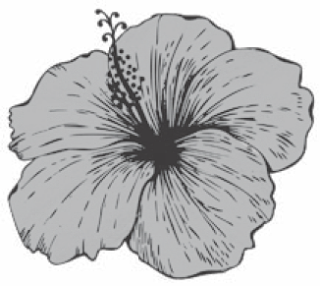 |
| Psychic Power in Existence, (Hibiscus rosa-sinensis), medium sized pink flower |
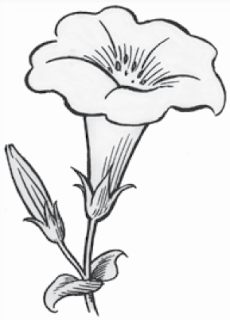 |
| Pure Sense of Beauty, (Ipomoea) light blue in colour |
But this kind of wish to gain by what one has or does is truly one of the ugliest things in the world. It is one of the most widespread and has become so widespread, that it is almost spontaneous in man. Nothing can turn its back on the divine love more totally than that, that wish to calculate and profit.”
*
Do flowers love?
“This is their form of love, this blossoming. Certainly, when one sees a rose opening to the sun, it is like a need to give its beauty. Only, for us, it is almost unintelligible, for they do not think about what they do. A human being always associates with everything he does this ability to see himself doing it, that is, to think about himself, think of himself doing it. Man knows that he is doing something. Animals don’t think. It is not at all the same form of love. And flowers, so to speak, are not conscious: it is a spontaneous movement, not a consciousness that is conscious of itself, not at all. But it is a great Force which acts through all that, the great universal Consciousness and the great Force of universal love which makes all things blossom in beauty.
 |
| Love for the Divine, (Rose) |
*
 |
| Perpetual Vitality, (Pine tree) |
Have you never watched a forest with all its countless trees and plants simply struggling to catch the light-twisting and trying in a hundred possible ways just to be in the sun? That is precisely the feeling of aspiration in the physical — the urge, the movement, the push towards the light. Plants have more of it in their physical being than men. Their whole life is a worship of light. Light is of course the material symbol of the Divine, and the sun represents, under material conditions, the Supreme Consciousness. The plants have felt it quite distinct in their own simple, blind way. Their aspiration is intense, if you know how to become aware of it.”
*
Flowers teach us the charm of silence and also the self-giving that demands nothing in exchange.
Love of flowers is a valuable help for finding and uniting with the psychic.
Could you explain this more in detail?
Since flowers are the manifestation of the psychic in the vegetal kingdom, love of flowers would mean that one is drawn by the psychic vibration and consequently by the psychic in one’s own self.
When you are receptive to the psychic vibration, that puts you in a more intimate contact with the psychic in your own self. Perhaps the beauty of flowers too is a means used by Nature to awaken in human beings the attraction for the psychic.
What is the best way of opening ourselves to the deep influence of flowers?
It is to love them. If you can enter into psychic contact with them, then that would be perfect.
How can one enter into a psychic contact with flowers?
 |
|
Psychic Soaring of Nature (Rose canina) light pink flower
|
When one is in conscious contact with one’s own psychic, one becomes aware of an impersonal psychic behind the whole creation and then, through this, one can enter into contact with flowers and know the psychic prayer they represent.
What is this impersonal psychic you spoke of?
By impersonal psychic I mean the psychic region which does not belong to any individual in particular—the psychic region which is in the creation, as air is in the earth’s atmosphere.
What is this psychic prayer that flowers represent?
The psychic, when it manifests in a plant, in the form of a flower, is in the form of a wordless prayer; it is the élan of the plant towards the Divine.
*
An Old Chaldean Legend
This is a story the Mother wrote on the pomegranate flower that does not give fruit.
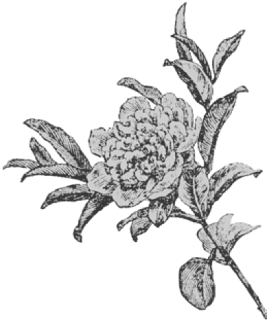 |
| Divine Love, (Pomegranate) |
While, drop by drop, the sacred blood fell, fertilising the soil, the bush covered itself with marvellous flowers, scarlet, enormous clusters of petals, innumerable drops of blood. These are the flowers that, for us, express and hold the Divine Love"
The Mother
(a short biography)
Mirra1 was her name and she was by nature “a very silent child.” Her mother often told her, whenever she complained about the food or some other petty thing: “You know, you are born to realise the highest Ideal.” And she sent her packing. She was indeed a very matter-of-fact woman and in time proved quite right.
 |
| Mirra, 7 years old |
Mirra had clearly from childhood an awakened life, for she could sit by herself in her little chair and “look into things.” At these times she often saw a beautiful light above her head and tried to bring it down!
Her sensitivity to plants began early. She enjoyed admiring maiden-hair ferns for hours when she was taken by her parents to certain friends of the family.
 |
| Tree |
At the age of fifteen she went to study for several years at an art school in Paris. There, her artistic talent as well as a new sensibility and appreciation of beauty blossomed. In fact, her motto throughout life was to study, to master herself and to become more conscious. However in her case, everything happened in her life naturally and often experiences came to her unsought.
Mirra was twenty-five when she went to Tlemcen in Algeria to study occultism with two great occultists, Max Théon and his wife Alma. All that we cannot see or touch, all the occult phenomena became clear and visible to her. It was during this period that she became aware too of the subtle power of flowers especially from Alma.
 |
| Sri Aurobindo |
In 1914 she came to Pondicherry and met Sri Aurobindo. She wrote in her diary: “It matters not if there are hundreds of beings plunged in the densest darkness. He whom we saw yesterday is upon earth. His presence is enough to prove that a day will come when darkness shall be transformed into light, when Thy reign shall be indeed established upon earth.”
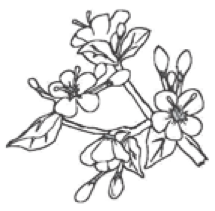 |
| Cherry Blossoms |
She returned to Pondicherry for good in 1920 and lived as the other disciples. However, after some years Sri Aurobindo began addressing her as Mother instead of addressing her as Mirra. For he wrote: “We have from the beginning followed the same path and have had the same experiences and realisations.” In November, 1926, when he retired he gave the Mother the full charge of the day to day activities of the disciples. This was the actual beginning of the Ashram.’
All that was unique, beautiful, simple and sincere is what gave the Mother most joy. We do not know at what moment the offering of flowers became the way of expressing the disciple’s aspiration and love for the Mother. Of course, she herself set the example showing that subtle way of communion by offering to Sri Aurobindo a garland of jasmine (she called this flower purity) each evening. We know that in India flowers are always used for offering in religious ceremonies and in temples.
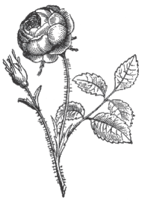 |
| Love for the Divine, (Rose) |
By the end of 1929 she had already given a spiritual name to more than a hundred flowers. The gardeners of the Ashram began growing as many flowers as possible and tried out growing many new ones too. The Mother was particularly fond of roses! They are named ‘Love for the Divine’. So the disciples began painting or embroidering flowers on fabric for the Mother’s use.
 |
| The Mother |
By 1953 Lizelle Raymond helped to compile all the names of the flowers named by the Mother. The book was titled “Le Rôole des Fleurs”. There were more than six hundred!
Here is an extract from Lizelle’s introduction:
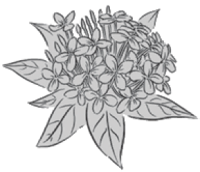 |
| Aspiration in the Physical (Ixora) |
The Ashram school grew and by 1952 became what is now the Sri Aurobindo International Centre of Education. Several new significances were given by the Mother, such as the “Thirst for Perfection” and the “The New World,” representing what she was bringing down, we believe, on the material plane.
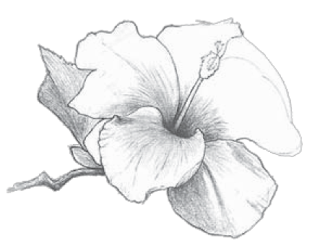 |
|
Beauty of Supramental love (Hibiscus rosa-sinensis) salmon pink flower
|
Later, between 1964 and 1968, The Mother prepared to realize a long cherished dream: the founding of an international city to become the living embodiment of an actual human unity. It was to be called Auroville and situated near Pondicherry. For this “City of Dawn (Auroville)” the first flower she named was “Godhead.”
Quite a few other Hawaiian hibiscus were named for this new venture, such as “The spiritual beauty of Auroville,” afterwards renamed “The Power of Spiritual Beauty.” Quite aptly she named a little Star of Bethlehem the “Beauty in Collective Simplicity.”
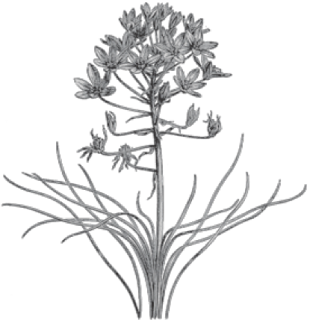 |
| Beauty in Collective Simplicity (Ornithogalum Umbellatum), white in colour |
It was between 1970 and 1971 that the Mother revised all the names and added a short commentary for each flower. At that time she also replied to various questions, some of which are included in this text.
1 A name is a variant of Mira (Latin, Slavic, Hindi) and Miranda (Latin), meaning “wonderful; peace; prosperous; worthy of admiration”.↩